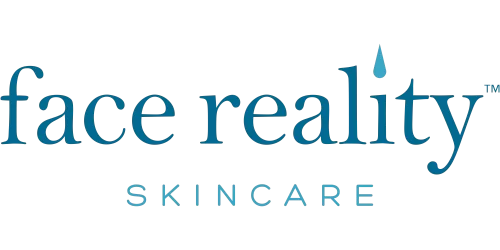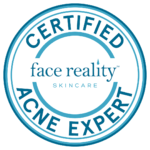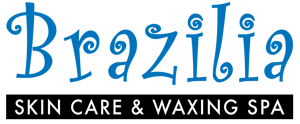Acne Clinic Treatments
Acne programs tailored uniquely to you


-
Face Reality Acne Clinic Facial $125
Our acne facial is customized with all Face Reality acne products and is designed to calm and treat acne. This treatment includes a thorough cleansing, steam, gentle exfoliation, extractions, high frequency, and a calming treatment mask.
-
Acne Peel or Enzyme Treatment $140
This treatment allows little to no downtime and involves gentle exfoliation to help boost your skins cellular turnover reducing breakouts, preventing future breakouts, and can assists with reducing scarring. This treatment includes thorough cleansing, a personalized peel or enzyme, extractions, and high frequency to help kill bacteria.
-
Face Reality Acne Back Treatment $135
Breakouts on the back can be stubborn and feel impossible to treat. Our back treatment includes either a peel or enzyme treatment to encourage healing of back acne. This treatment includes thorough cleansing, a personalized peel or enzyme, extractions, and high frequency to help kill bacteria.
- LED $25
LED therapy treats acne, inflammation, and aging.
- Additional Area $50
You can treat multiple areas at once with this customized appointment! Acne can affect your back and chest as well. Combine two areas and save.
What is the root cause of your acne?
Your acne consultation will evaluate every factor of your lifestyle, diet and current products that could be triggering acne. With this information and a detailed analysis of your skin we will create a new skincare regimen designed specifically for you.
This regimen will consist of all Face Reality acne products and will be adjusted over the next 12 weeks if needed.
- It can take up to 90 days for acne to fully surface.
- It can take up to 3-4 months to clear acne.
- Our acne treatments with home care products have a 90% success rate.
- 80% of your success is from home care regimen.
Lifestyle Choices Affecting Acne
Laundry
Fabric Softener
Do not use this in the washer and/or the dryer (no dryer sheets). The waxy residue gets on your
pillowcases, towels, wash cloths, and sheets that have direct contact with the skin. The residue will
clog pores of acne-prone individuals. If you want something to stop static cling in your dryer, you
can get anti-static balls at Bed Bath and Beyond, Target, or online.
Detergent
Detergents with fragrance can cause skin irritation. Best to use fragrance-free such as Cheer Free, All
Free & Clear, Tide Free, and Arm & Hammer Free.
No water softeners
Detergents with fragrance can cause skin irritation. Best to use fragrance-free such as Cheer Free, All
Free & Clear, Tide Free, and Arm & Hammer FreeThere is some evidence that water softeners can lead to acne, especially those containing high
amounts of potassium chloride..
Swimmers
Sun Exposure and Acne
Although sun exposure causes desirable scaling and drying, it also damages the follicle, exacerbates
dark spots, and causes skin cancer as well as premature aging. Always wear your sunscreen, even if
it’s overcast and/or raining.
Beware of Hand Lotions
Breakouts Around Your Mouth Area?
No Picking or Squeezing!
Birth Control and Hormone Replacement
Recreational and Prescription Drugs
Chemicals
Coal tars (roofers), grease (mechanics, cooks, waiters), chlorinated industrial chemicals, dioxin.
Detergents with fragrance can cause skin irritation. Best to use fragrance-free such as Cheer Free, All
Free & Clear, Tide Free, and Arm & Hammer Free.
Food and Supplements Affecting Acne
Foods
This is a guideline only—We are not asking you to eliminate foods or food groups completely; we do suggest you cut back and moderate some food types. The “Try to Reduce” group has been proven to be a problem for most acne sufferers. We also know that some people have trigger foods such as citrus, but this is not across the board.
Try To Reduce | Acceptable Substitute |
|---|---|
| Iodides | |
| Iodized Salt | Sea Salt, Uniodized Salt, Celtic Salt |
| Iodides Iodized Salt Sea Salt, Uniodized Salt, Celtic Salt Milk (including organic and especially nonfat) | Almond Milk, Coconut Milk, Rice Milk |
| Cheese | Nut cheese |
| Whey or Soy Protein Shakes and Protein Bars | Pea Protein, Egg White Powder, Hemp – still check for iodides and biotin before buying (Vega Sport Performance Protein & Perfect Fit are a few safe ones.) |
| Soy – e.g., tofu, soy milk, tempeh, edamame, soy sauce | |
| Seafood, Shellfish e.g., cod, scallops | Fresh Water Fish – lake trout, bass, catfish |
| Spirulina, Chlorella, Blue-Green Algae | |
| Kelp, Miso Soup, Seaweed, Seaweed Supplements | |
| Vitamins with iodides, iodine, kelp, potassium iodide (also avoid Biotin and B12) | |
| Foods High in Androgens | |
| Peanuts, Peanut Butter | Almond Butter or other nut butters |
| Peanut Oil, Corn Oil, Canola Oil | Olive Oil, Coconut Oil |
| Shellfish | |
| Organ Meats including patè |
Supportive Foods/Beverages
- Ceylon Cinnamon
- Apple Cider Vinegar
- Green Tea especially Matcha
Antioxidant “Helper” – foods high in Selenium
Anti-inflammatory Support
- Turmeric
- Ginger
- Green Tea (especially Matcha)
- Ceylon Cinnamon
- Foods high in Vitamin B3
- Crimini Mushrooms
- Tuna
- Chicken Breast
- Fish (Halibut, Salmon, Sardines)
- Leafy Greens
- Asparagus
- Foods high in Omega-3
- Fatty Fish
- Salmon
- Sardines
- Atlantic Mackerel
- Anchovies
- Herring
- White Fish
- Omega-3 Enriched Eggs
- Walnuts
- Deep Leafy Greens – Spinach, Kale,
- Watercress
- Blueberries
- Hemp Seeds
- Mustard Seed
- Brussel Sprouts
- Winter Squash
- Navy Beans
Foods That Cause Inflammation:
Trans Fats
- Cakes, pies and cookies
- Biscuits
- Breakfast sandwiches
- Margarine (stick and tub)
- Crackers
- Microwave popcorn
- Cream-filled candies
- Doughnuts
Overheated fats – baked foods/ fried at high temperatures
Excess Sugar
Omega-6 oils (most vegetable oils) and not enough Omega-3s
Known Food sensitivities (examples – fruit, gluten)
A well-balanced low-glycemic diet can support all aspects of health, including your skin.
Supplements
Anti-inflammatory Supplements
Zinc Monomethionine
This form of zinc is the most bio-available form that acts directly as an anti-inflammatory. Many
people with acne have low levels of zinc in their body. Supplementing with zinc has been shown to
reduce the severity of cysts and inflamed lesions. It has also been shown to be beneficial for helping
improve many of the dermatological symptoms in women with PCOS (Polycystic Ovary Syndrome).
Omega 3 Fish Oils
Gut Health
Probiotics
Antioxidant Support
The acne-prone are generally lower in antioxidants than the general population. We recommend getting your antioxidants from fresh food sources, but here is the RDA for them.
Vitamin A – 700 mcg – women; 900 mcg – men
Vitamin C – 75 mcg – women; 90 mg – men
Vitamin E – 15 mg
Zinc – 30 mg
N-Acetylcysteine – 1000 to 1500 mg
Selenium – 55 mcg (antioxidant assistant)
Insulin Support
Elevated insulin stimulates androgen production which stimulates more oil and increased sensitivity to androgen’s effects on the skin. It’s best to get insulin support by wise food choices, but here is the
RDA.
Berberine – 500-1000 mg
Chromium – 150 mcg
Vitamin D – 400-800 IU
Choosing a High Quality Omega-3 Fish Oil
Omega-3 fatty acids are found in high concentrations in cold water ocean fish such as sardines, anchovies, herring, salmon and mackerel. Research indicates that Omega-3 fish oil promotes an anti-inflammatory response in the body, preventing and improving symptoms of common diseases and ailments. Studies have shown that people who suffer from chronic inflammatory acne may benefit from taking therapeutic doses (1000-1700 mg) of purified omega-3 oils daily.
With recent scares regarding the purity of ocean fish, and thereby the safety and efficacy of supplements derived from them, it is a good time to revisit how to go about choosing a high-quality fish oil supplement.
Use the checklist below to help you select a superior and effective fish oil supplement.
The label is important, so read it. The vital ingredients in fish oil supplements are omega-3 fatty acids, or EPA and DHA. These two fatty acids are the only ones that matter in reducing inflammation and chronic breakouts. The amount of each should be shown separately and should total between 1,000-1,700 mg per serving. There should be a higher ratio of EPA to DHA, about 2:1 or thereabouts. Many labels simply mention the total count of omega-3 fatty acids. This information is not helpful because you don’t know the actual amount of EPA and DHA. Similarly, if the EPA and DHA is stated on the bottle, but in lower amounts, be sure you will be able to take all the capsules necessary to get your daily dosage of 1,000-1,700 mg. Some popular drugstore and health food brands have such a low amount of EPA and DHA that one would have to take 12 capsules just to get the adequate daily amount!
Look for molecularly distilled or pharmaceutical grade fish oil. This should be mentioned on the label. This is the highest grade fish oil because it is molecularly distilled, avoiding oxidation of the fish oil. This is also the only process that successfully removes impurities and contaminants (mercury, dioxins, PCBs, etc.). Lastly, it produces a more concentrated form of fish oil with higher potencies of EPA and DHA, so less capsules to swallow!
Find out some information about the manufacturer. Check out some other products they produce. Do some research to see how long they have been in business and if they have a good reputation. Here is a great website for comparing brands: https://certifications.nutrasource.ca/
Look for capsules that have enteric coating. This coating ensures that the capsules will break down lower in your digestive tract, not in the stomach, minimizing those unpleasant fishy burps that many people experience after taking fish oil supplements.
Look for Vitamin E. Vitamin E helps to prevent oxidation during storage, keeping the oils from turning rancid. Vitamin E will usually be listed under “Other Ingredients” as tocopherols or mixed tocopherols.
By carefully choosing the right fish oil supplement, you optimize the potential benefits that Omega-3 fatty acids can impart to you. Many health practitioners agree there are many benefits to taking a quality fish oil supplement, especially for the immune system, heart, brain and joints. Of special interest to acne sufferers, they may help regulate hormones, minimizing the intensity and duration of inflammatory breakouts.
*Please note: Although there is no known toxicity associated with using fish oils over long term, you should check with your physician particularly if you have a chronic underlying illness or are pregnant. According to the FDA, you should not take more than 2,500 mg of Omega-3s daily unless under the recommendation of a physician.
Zinc Supplements
These supplements can upset your stomach. To prevent nausea, always take OptiZinc with food.
Zinc is an essential trace element for humans and there is evidence that it is similar to antibiotics in improving the condition of inflamed acne. The effective dosage is not clear. However, most studies indicate 50-100mg (The OptiZinc tablet that we sell are 30MG). We advise you to not take any more than 100mg because excessive zinc may lead to deficiencies in other vitamins and minerals. One of the reasons that we like OptiZinc is that it contains copper and copper is one of the minerals that can be depleted by taking zinc supplements.
We also recommend discontinuing daily use of zinc once your skin is completely clear. We are not recommending this as a preventative.
If you would like more information to help you make decisions about the benefits, proper dosage and best formulation of zinc supplements, we highly recommend doing further research and consulting with your doctor.
Pore Clogging Ingredients in Skin Care
Warnings
Makeup
- Acetylated Lanolin
- Ethylhexyl Palmitate
- PEG 16 Lanolin
- Acetylated Lanolin Alcohol
- Glyceryl Stearate SE
- PEG 200 Dilaurate
- Algae Extract
- Glyceryl-3 Diisostearate
- PEG 8 Stearate
- Algin
- Hexadecyl Alcohol
- PG Monostearate
- Butyl Stearate
- Hydrogenated Vegetable
- PPG 2 Myristyl Propionate
- Carrageenan Oil
- Plankton
- Cetyl Acetate
- Isocetyl Alcohol
- Polyglyceryl-3 Diisostearate
- Cetearyl Alcohol + Ceteareth
- Isocetyl Stearate
- Potassium Chloride 20
- Isodecyl Oleate
- Propylene Glycol
- Chondrus Crispus (aka Irish
- Isopropyl Isostearate Monostearate Moss or Carageenan Moss)
- Isopropyl Linolate
- Red Algae
- Chlorella
- Isopropyl Myristate
- Seaweed
- Coal Tar
- Isopropyl Palmitate
- Shark Liver Oil (Squalene)
- Cocoa Butter
- Isostearyl Isostearate
- Shea Butter
- Coconut Alkanes
- Isostearyl Neopentanoate
- Sodium Laureth Sulfate
- Coconut Butter
- Kelp
- Sodium Lauryl Sulfate
- Coconut Oil
- Laminaria Digitata Extract
- Solulan 16
- Colloidal Sulfur
- Laminaria Saccharina
- Sorbitan Oleate
- Cotton Awws Oil Extract (Laminaria
- Soybean Oil (Glycine Soya)
- Cotton Seed Oil Saccharine)
- Spirulina
- D & C Red # 17
- Laureth-23
- Steareth 10
- D & C Red # 21
- Laureth-4
- Stearic Acid Tea
- D & C Red # 3
- Lauric Acid
- Stearyl Heptanoate
- D & C Red # 30
- Mink Oil
- Sulfated Castor Oil
- D & C Red # 36
- Myristic Acid
- Sulfated Jojoba Oil
- Decyl Oleate
- Myristyl Lactate
- Wheat Germ Glyceride
- Dioctyl Succinate
- Myristyl Myristate
- Wheat Germ Oil
- Disodium Monooleamido PEG
- Octyl Palmitate
- Xylene 2- Sulfosuccinate
- Octyl Stearate
- Ethoxylated Lanolin
- Oleth-3
- Oleyl Alcohol

